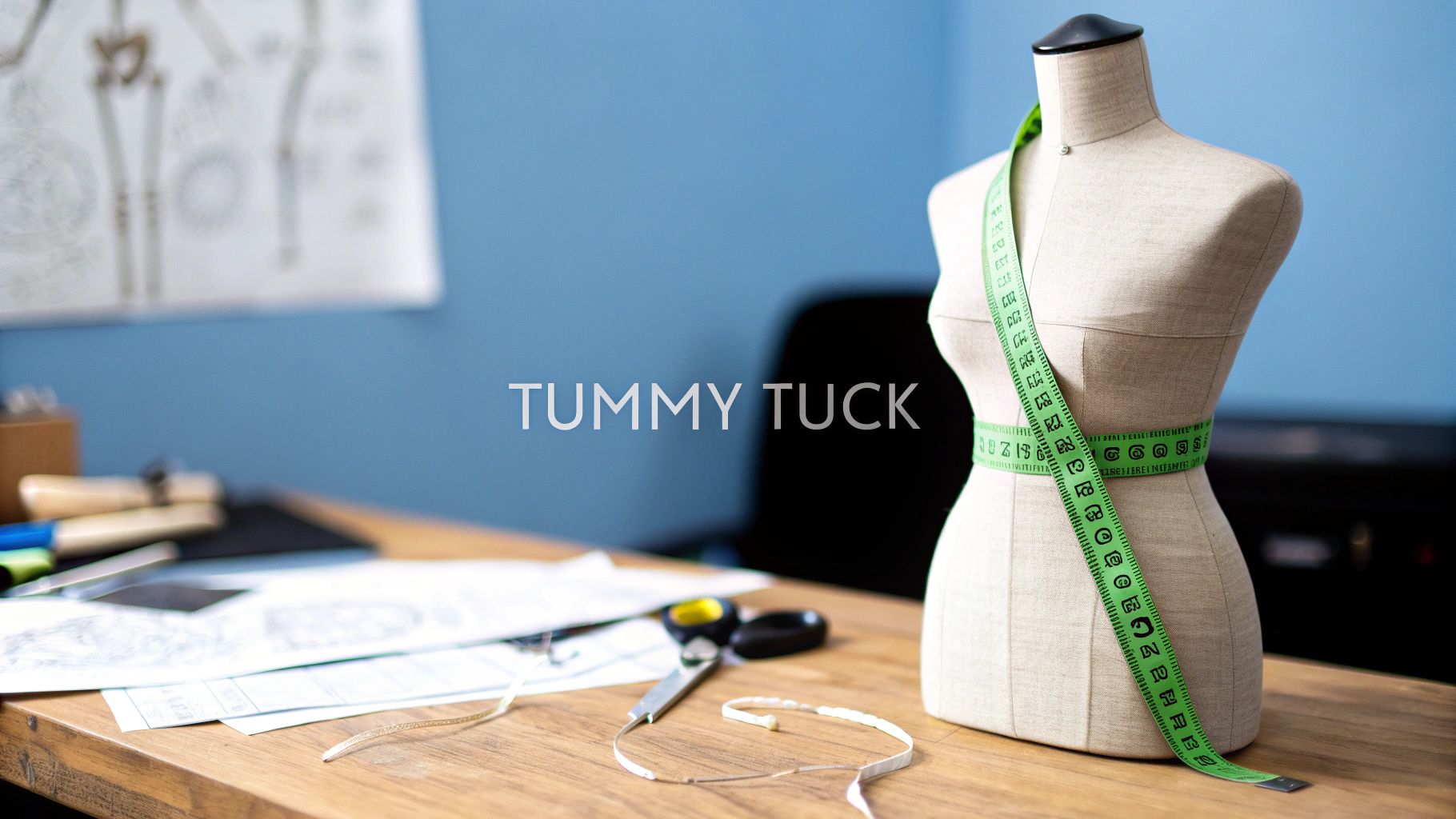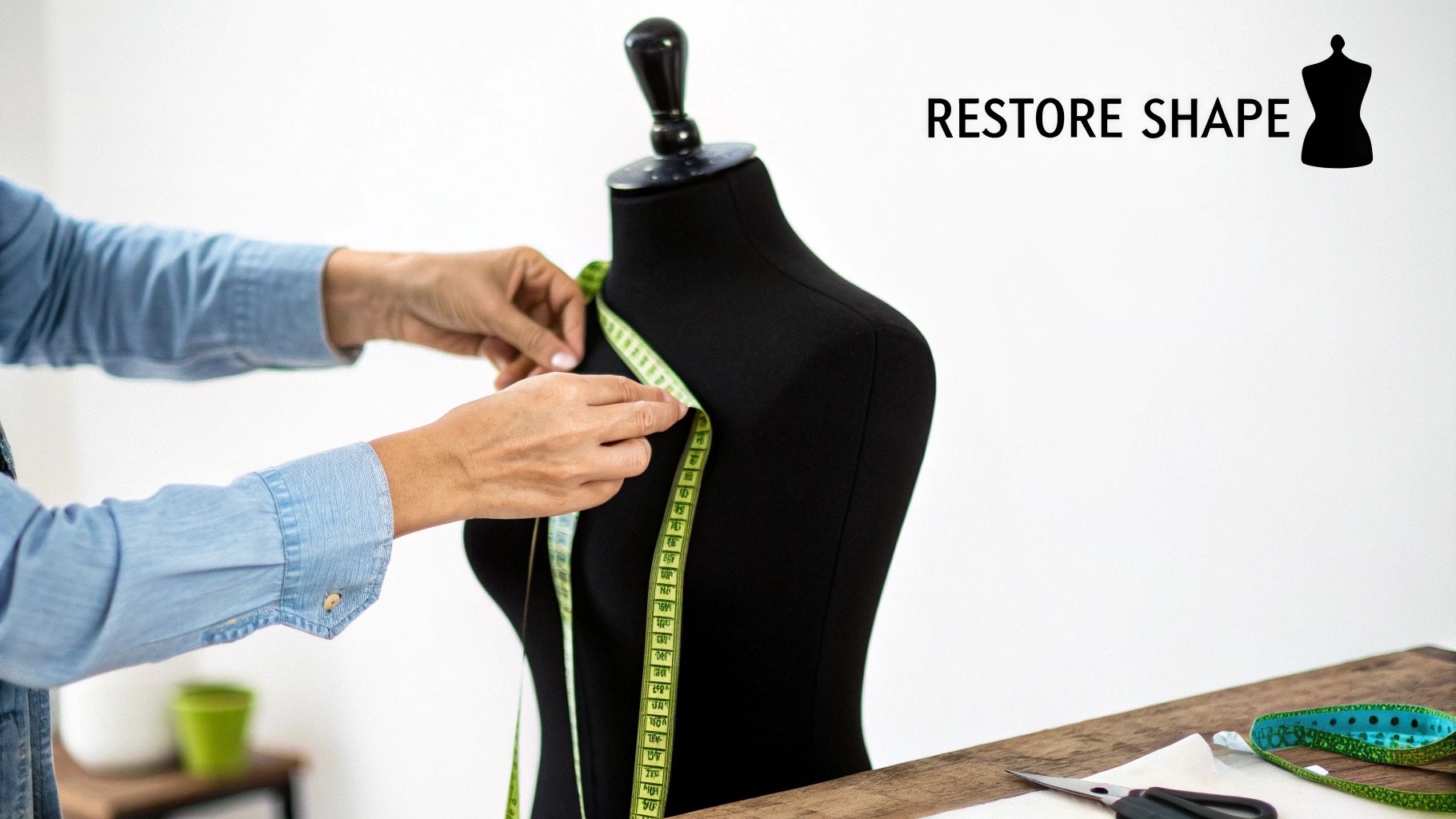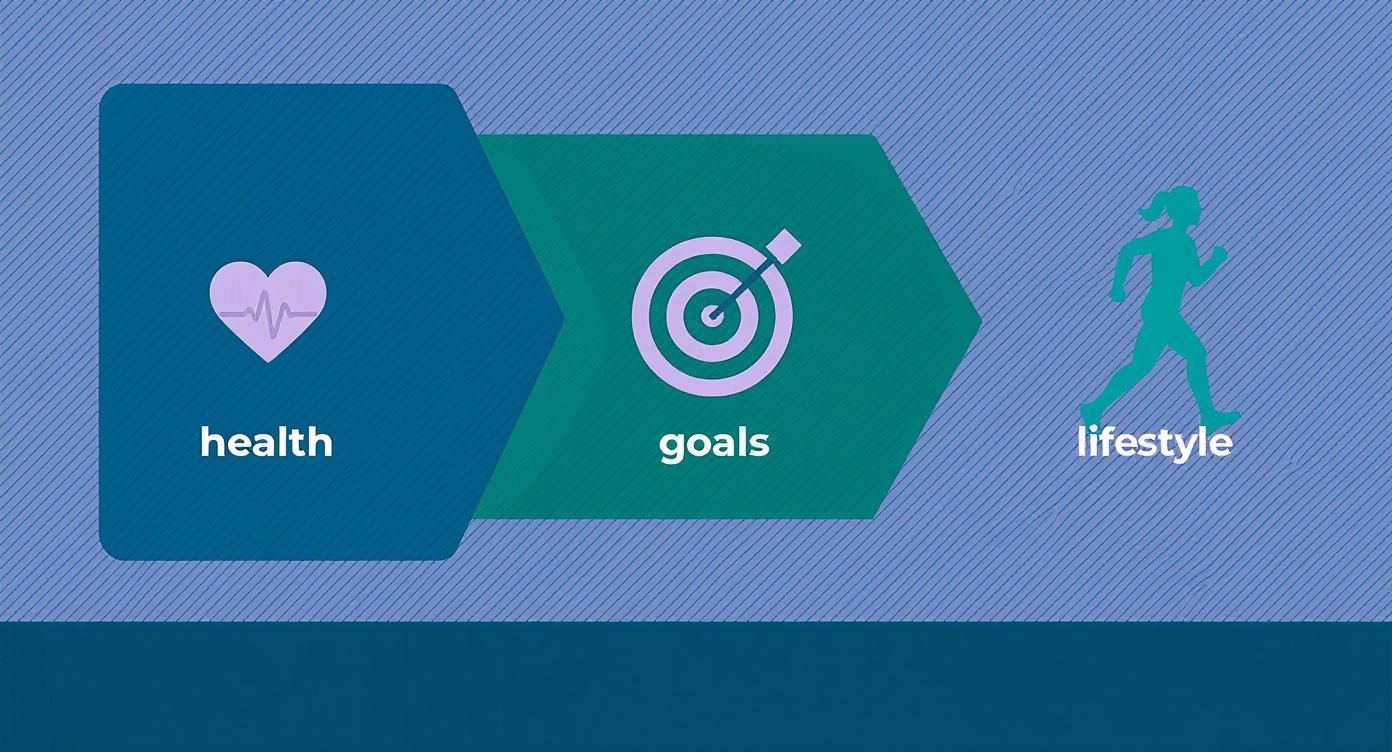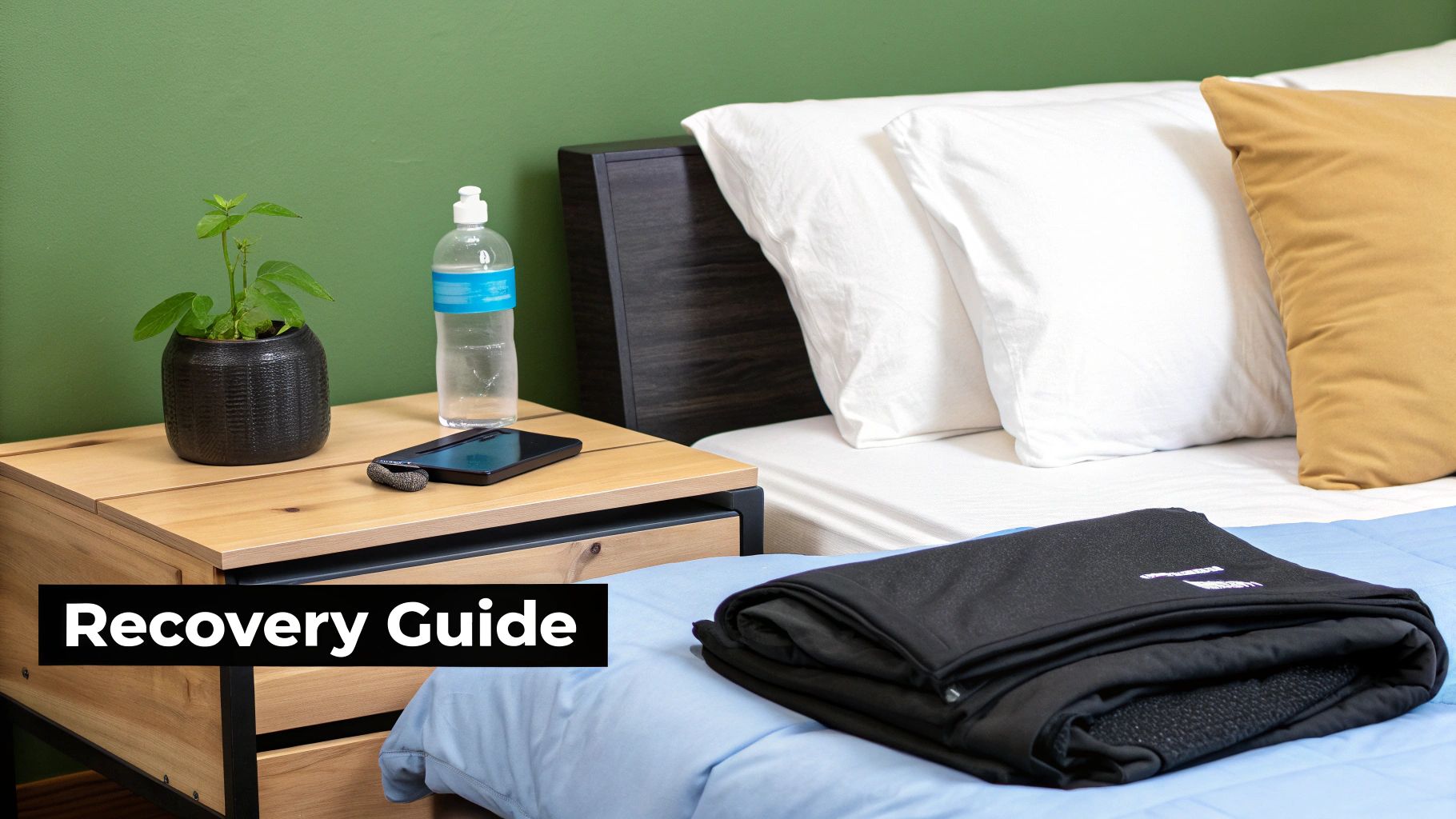
December 10, 2025
A Patient's Guide to Nonsurgical Cosmetic Procedures
Explore popular nonsurgical cosmetic procedures like Botox and fillers. Learn how they work, the benefits, costs, and what to expect from an expert guide.
Oct 25, 2025

A tummy tuck, known in medical terms as an abdominoplasty, is a surgical procedure that goes far beyond simple fat removal. Its real purpose is to sculpt and restore the abdomen by removing loose, excess skin and tightening the underlying muscles that have weakened or separated. The result is a flatter, firmer, and more toned stomach profile.

It’s best to think of a tummy tuck as a complete restoration of your midsection. It’s not just about making the area smaller; it’s about rebuilding the core structure and returning it to a more youthful, athletic shape that diet and exercise often can't achieve alone.
This is especially true for people who have experienced major life events like pregnancy or significant weight loss. These events can leave behind lasting changes that no amount of crunches can fix. A tummy tuck specifically targets these issues head-on.
The first problem a tummy tuck solves is excess, sagging skin. Once skin has been significantly stretched, it loses its natural elasticity and can't just snap back into place. A tummy tuck is the only way to surgically remove this extra skin, leaving behind a smooth, taut surface.
The second, and perhaps most impactful, goal is repairing the abdominal muscles. During pregnancy or after major weight gain, the two main vertical muscles in your abdomen can pull apart. This common condition is called diastasis recti, and it's the culprit behind that stubborn "pooch" that won't go away, even when you're at a healthy weight.
A crucial step in any full tummy tuck is when the surgeon stitches these separated muscles back together. This acts like an internal corset, instantly flattening the stomach and creating a more defined, narrower waistline.
Not all tummy tucks are created equal. The right procedure for you depends entirely on your specific anatomy and aesthetic goals. It’s a highly personalized surgery, and understanding the main variations can help you set realistic expectations.
To get a clearer picture of what's possible, it’s always helpful to look at real-life examples. Reviewing a gallery of tummy tuck before and after photos can give you a much better sense of the kind of results each technique delivers.
It's no surprise that body contouring procedures are becoming more popular. For example, liposuction procedures jumped by 134% in 2022 alone. This trend shows a clear desire for comprehensive aesthetic solutions that create lasting, noticeable change.
Deciding on a tummy tuck is a big step, and honestly, it’s not the right move for everyone. The best results happen when the surgery is a perfect match for a person's health, lifestyle, and what they truly hope to achieve. Figuring out if you’re a great candidate isn't about ticking boxes on a list; it’s a real conversation about your goals, what's possible, and whether the timing is right.
Think of it like this: you wouldn't just decide to run a marathon tomorrow. You’d train for it. In the same way, the best candidates for a tummy tuck have already done the hard work with diet and exercise. They’re looking for that final, finishing touch to fix things that no amount of crunches or calorie counting can.
So, who is the perfect person for an abdominoplasty? It's usually someone who is in good overall health but is really bothered by specific issues with their midsection—the kind of changes that often stick around after major life events like having kids or losing a lot of weight.
A strong candidate usually has a few things in common:
An ideal candidate is someone who sees a tummy tuck as a restorative final step. Think of a mom who wants to get her pre-baby core strength back, or someone who has successfully lost 100 pounds and now wants to remove the leftover skin to complete their incredible journey.
Just as important as knowing who’s a good fit is recognizing when it's better to wait. Sometimes, putting the procedure off is the smartest and safest decision you can make. The ultimate goal is a result you'll love for years to come.
There are definitely a few situations where it's best to hold off for now.
When it comes down to it, the only way to know for sure is to sit down and talk with a board-certified plastic surgeon. They can take a look at your specific situation, listen to what you're hoping for, and give you a personalized, honest recommendation to help you make a decision you feel great about.
Walking into surgery can feel daunting, but knowing exactly what to expect on the day of your tummy tuck can make all the difference. Understanding the process helps replace anxiety with a sense of calm and confidence.
Think of it this way: your surgeon is a skilled artist, and the operating room is their studio. They have a detailed plan to repair and reshape your abdomen, bringing out the contours you've been working toward. Let's walk through the entire experience, from the moment you arrive until you're resting comfortably in recovery.
The infographic below highlights the essential checks we perform before any procedure, making sure your health, goals, and lifestyle are all aligned for a great outcome.

This preparation is key to ensuring every patient is physically and mentally ready for a safe and successful surgery.
When you arrive at the surgical facility, our medical team will get you settled in and start the final preparations. You'll have another chance to chat with your surgeon, go over the plan one last time, and ask any lingering questions you might have.
Then, your surgeon will use a special marker to draw guidelines on your abdomen. This isn't just a quick sketch; it’s a precise blueprint that maps out the incisions and the new placement for your belly button. This step is crucial for achieving symmetrical, natural-looking results.
Once you’re in the operating room, the anesthesiologist will administer general anesthesia. You'll drift off to sleep and remain completely comfortable for the entire surgery, feeling no pain and having no awareness of the procedure itself. Throughout the operation, your vital signs are monitored constantly to ensure your safety.
With you resting peacefully, the team preps the surgical area, and your surgeon begins. It's no wonder tummy tucks have grown so popular; in 2020, abdominoplasty was one of the top five cosmetic surgeries performed worldwide. It's especially sought after by people who've lost a significant amount of weight and want to address the loose skin and separated muscles left behind. You can dive deeper into the numbers by reviewing these tummy tuck trends and patient demographics.
The tummy tuck itself is a series of precise, deliberate steps. Each one builds on the last to create that smoother, firmer abdominal profile you're looking for.
Here’s a breakdown of what the surgeon is doing:
To finish, the surgeon will typically place temporary drains to keep fluid from building up, apply sterile dressings, and fit you into a snug compression garment. This garment is essential for minimizing swelling and supporting your tissues as they heal.
After the surgery is complete, you'll be moved to a recovery area. A dedicated nursing team will watch over you as you slowly wake up from the anesthesia. It's totally normal to feel groggy at first. Once you're stable and alert, you'll be cleared to head home with a trusted friend or family member to start your healing journey.

The success of your tummy tuck doesn't end when you leave the operating room—in many ways, that’s where the next important chapter begins. Your recovery is when your body gets down to the crucial work of healing, and your new, sculpted contours start to take their final shape.
Think of it like this: the surgery is the blueprint, but the recovery is the careful construction process. It takes patience and the right care for everything to settle beautifully. To give you a clear picture of what's ahead, let’s walk through the first month, week by week. Knowing what's coming can make the entire journey feel much more manageable.
The first 7 days are all about one thing: rest. You'll wake up from surgery feeling groggy, sore, and swollen. Your abdomen will be bandaged and wrapped in a compression garment, which is absolutely essential for keeping swelling down and giving your healing tissues the support they need.
Don't expect to be moving around much. Standing up straight will be off the table for a bit, as your newly tightened abdominal muscles need to adjust. Most patients find themselves walking slightly bent at the waist, and a walker can be a huge help during these first few days.
This first week is often the toughest, both physically and emotionally. It's so important to remember that this part is temporary. Focus on taking short, gentle walks around the house to keep your circulation going and help prevent blood clots.
Sleeping propped up is another non-negotiable. Whether you use a wedge pillow or camp out in a recliner, this position reduces swelling and takes the tension off your incision. Your surgeon will give you a detailed plan for managing pain and caring for any surgical drains you may have.
By the second week, you should start to feel a real shift. The initial, intense discomfort will begin to fade, and you'll notice your energy levels slowly climbing back up. Getting around will feel easier, but it's still crucial to avoid any heavy lifting or strenuous activities.
This period is a balancing act. You need to keep moving with short, slow walks to promote blood flow—a key ingredient for speedy healing—but you also need to listen to your body and rest when it tells you to.
A few key things happen this week:
For a deeper dive into making this phase as smooth as possible, our guide to tummy tuck recovery tips is packed with helpful advice.
This is when you really start to feel like yourself again. The swelling and bruising will have gone down significantly, offering you a much clearer glimpse of your final results. As you continue to heal, it can be fascinating to understand the science behind it, like the importance of collagen in skin health and how it rebuilds your tissues.
Your surgeon will likely clear you to slowly ramp up your activity levels. We're not talking about hitting the gym for a high-intensity workout just yet. Think more along the lines of longer walks or maybe some gentle stationary biking.
By the end of your first month, you can generally expect to:
Just remember, everyone’s body heals at its own pace. Your surgeon's aftercare instructions are tailored specifically to you—follow them closely. The surest way to get the beautiful, lasting results you want is to listen to your body and give it the time and care it needs.
https://www.youtube.com/embed/PChNJrTZyC8
Deciding to get a tummy tuck is a big deal, and walking into it with your eyes wide open is the smartest way to go. While most people are thrilled with their results, it's still a major surgery, and that means it comes with risks. This isn't about scaring you—it's about empowering you to make choices that protect your health and lead to the best possible outcome.
Some of the more common issues that can pop up are things like scarring, infection, or a pocket of fluid building up under the skin (called a seroma). Your surgeon will do everything they can to prevent these, but your role in recovery is just as important. Following your after-care instructions to the letter is one of the most powerful things you can do for your own safety.
If there's one decision that outweighs all others in keeping you safe, it's choosing the right surgeon. Their credentials and experience aren't just lines on a resume; they're the bedrock of a safe procedure and a fantastic result.
When you're doing your research, these qualifications are non-negotiable:
Think of your consultation as an interview—you're the one hiring. Ask direct questions about their experience, their complication rates, and the specific safety measures they have in place. A good surgeon will respect and welcome this conversation.
While your surgeon is the captain of the ship, you're a crucial member of the crew. Tummy tucks are incredibly popular, with 171,064 performed in a recent year, but that doesn't mean they're risk-free. Even with a low overall complication rate (one study put it around 9.7%), it's a number that underscores why your participation matters so much.
Understanding what could go wrong is the first step toward preventing it. You can get a broader view by reading about the risks associated with various aesthetic treatments, which really drives home why putting your trust in a professional is so important.
Ultimately, your safety is a partnership. By picking a highly qualified, board-certified plastic surgeon and committing to their pre- and post-op instructions, you're doing everything in your power to ensure a smooth recovery and a result you'll love for years to come.
Even after doing your research, it's natural to have a few more practical questions floating around. Let's walk through some of the most common ones people ask, so you can get the clear, straightforward answers you're looking for.
Think of it as double-checking the little details before a big trip. You've got the destination in mind, but now it's time to confirm the specifics to make sure the journey is a smooth one.
Let's talk about the bottom line, because cost is a major consideration for everyone. A tummy tuck is a significant investment in yourself, and it's helpful to know exactly what goes into that final number. The price you're quoted isn't just one flat fee; it's a combination of a few key things.
The total cost is typically broken down into three main components:
It's important to know that a tummy tuck is almost always classified as a cosmetic procedure, which means health insurance won't cover it. You'll be responsible for the full cost out-of-pocket. The good news is that many plastic surgery practices offer financing plans through trusted medical credit companies, which can break down the total into more manageable monthly payments.
This is a great question, and one we hear all the time. The honest answer is that a tummy tuck will leave a permanent scar, but a skilled surgeon’s primary goal is to make it as subtle as possible. I like to compare it to a master tailor who hides a seam on the inside of a custom-made suit—it's essential for the structure, but it shouldn't be what people notice.
The main incision for a full tummy tuck runs horizontally from one hip to the other. Your surgeon will carefully place this incision very low on your abdomen so it can be easily hidden by underwear or a bikini bottom. You'll also have a small, discreet scar around or inside your newly positioned belly button.
Over time, scars go through a natural healing process. They usually start out looking pink or reddish but will slowly fade over the course of a year, eventually becoming a thin, pale line that blends in much better with your skin.
Modern surgical techniques and post-op scar care make a huge difference in the final result. Following your surgeon's instructions for scar management—which might include using silicone sheets or special creams—is one of the most important things you can do to help it heal beautifully.
Absolutely. It’s not only possible to combine a tummy tuck with other surgeries, but it's also incredibly common. This approach, often called a "mommy makeover," lets you address several concerns during a single operation. That means you only have to deal with one anesthesia fee and one recovery period.
A mommy makeover is a personalized set of procedures designed to help a woman restore her pre-pregnancy body. A typical combination often includes:
Bundling procedures can create a much more dramatic and cohesive transformation. It's like redecorating an entire room instead of just painting one wall—the final effect is more complete. Of course, patient safety is always the number one priority, so your surgeon will do a thorough health evaluation to make sure you're a good candidate for a longer surgery.
The great news is that the results from a tummy tuck are meant to be permanent. The excess skin that's removed is gone forever, and the abdominal muscles that are tightened will stay in their newly repaired position. The structural changes are built to last.
However, the longevity of your new, contoured shape really depends on your lifestyle after surgery. Your results aren't immune to major life events.
Here’s a good way to think about it: your surgeon has just handed you the keys to a high-performance car. To keep it running like new, you have to use the right fuel and keep up with maintenance. The same is true for your tummy tuck results. To protect your investment and enjoy your outcome for decades, you'll want to:
By committing to a healthy lifestyle, you can enjoy your flatter, firmer abdomen for many, many years to come.
At Cape Cod Plastic Surgery, we believe an informed patient is an empowered patient. If you have more questions or are ready to explore your options, we invite you to schedule a personalized consultation.

December 10, 2025
Explore popular nonsurgical cosmetic procedures like Botox and fillers. Learn how they work, the benefits, costs, and what to expect from an expert guide.

December 10, 2025
Exploring Your Breast Surgery Choices: From Cancer Treatment to Cosmetic Enhancements

December 9, 2025
Tired of looking tired? Uncover what causes under eye bags, from genetics to lifestyle, and explore expert-backed prevention tips and treatment options.